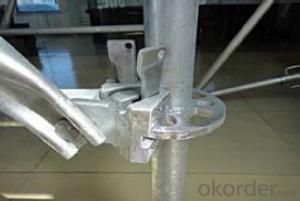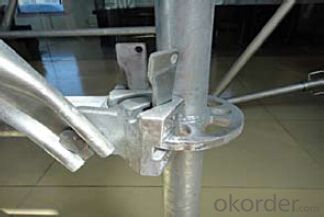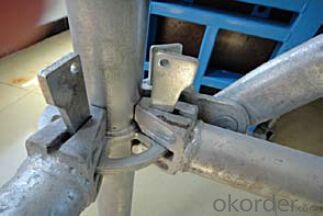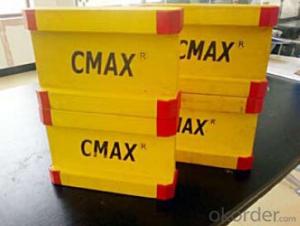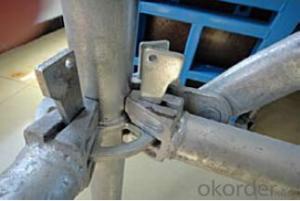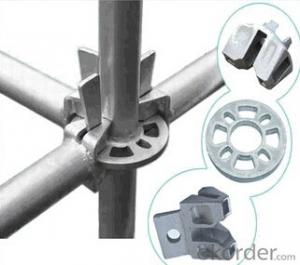Ring Lock Scaffolding Accessories for scaffolding systems
- Loading Port:
- Tianjin
- Payment Terms:
- TT OR LC
- Min Order Qty:
- 50 m²
- Supply Capability:
- 1000 m²/month
OKorder Service Pledge
Quality Product, Order Online Tracking, Timely Delivery
OKorder Financial Service
Credit Rating, Credit Services, Credit Purchasing
You Might Also Like
Ring-lock Scaffolding
A support system for construction, ownsadvantages of both cup-lock scaffolding andshoring tower.
It is in the development direction of new typescaffolding.
It is widely used in buildings, bridges, tunnels etc..
Characteristics:
◆ Easy to storage and transportation
◆ High degree of standardization
◆ Easy and quick erection
◆ Excellent stability and bearing capacity
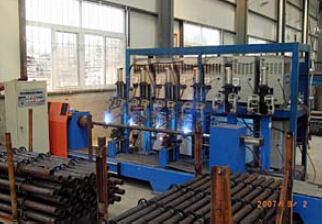
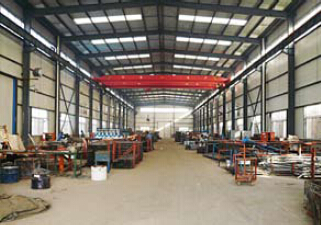
- Q: What are the different locking mechanisms used in steel formwork?
- There are several different locking mechanisms used in steel formwork to ensure stability and integrity during concrete construction projects. These mechanisms are designed to securely hold the formwork panels together and prevent any shifting or movement that may compromise the accuracy and quality of the final concrete structure. One commonly used locking mechanism is the wedge clamp system. This system consists of steel wedges that are inserted between the formwork panels and tightened using a hammer or mallet. The wedges create a strong connection between the panels, holding them tightly in place. Another popular locking mechanism is the pin and wedge system. This system involves the use of steel pins that are inserted through holes in the formwork panels. Then, steel wedges are driven into the holes, securing the pins in place. This creates a stable and secure connection between the panels. Some steel formwork systems also utilize a hook and loop mechanism. This involves the use of metal hooks that are attached to one panel and metal loops that are attached to the adjacent panel. The hooks and loops interlock, providing a strong connection between the panels. This mechanism is often quick and easy to use, making it a popular choice for certain construction projects. Additionally, some steel formwork systems use a combination of locking mechanisms. For example, a system may incorporate both wedge clamps and pin and wedge systems to provide extra stability and strength. Overall, the different locking mechanisms used in steel formwork serve the purpose of ensuring that the formwork panels remain securely connected throughout the concrete pouring process. Each mechanism has its advantages and may be more suitable for specific project requirements.
- Q: Can steel formwork be used for airport construction projects?
- Certainly, airport construction projects can make use of steel formwork. Steel formwork proves to be a versatile and long-lasting option when it comes to building various concrete structures within airports. Its attributes such as high strength, stability, and reusability offer multiple advantages, making it a suitable choice for extensive projects like airport construction. The robustness of steel formwork enables it to withstand the immense loads and pressures associated with airport infrastructure, thereby facilitating the construction of runways, taxiways, aprons, and other essential structures. Moreover, its modular design and flexibility allow for effortless customization and adaptation to cater to diverse project requirements. In summary, steel formwork emerges as a dependable selection for airport construction projects due to its durability, strength, and adaptability.
- Q: Can steel formwork be used for both straight and curved concrete elements?
- Yes, steel formwork can be used for both straight and curved concrete elements. Steel formwork is highly versatile and can be easily adjusted and shaped to accommodate different design requirements. It offers excellent strength and durability, making it suitable for constructing both straight and curved concrete elements. The flexibility of steel formwork allows for the creation of complex and intricate shapes, making it ideal for projects that require curved elements such as architectural features, curved walls, or circular structures. Additionally, steel formwork provides a smooth and uniform surface finish, ensuring high-quality concrete results for both straight and curved elements.
- Q: How does steel formwork affect the concrete finish?
- Steel formwork can have a significant impact on the concrete finish. Firstly, steel formwork provides a smoother and more uniform surface compared to other types of formwork materials such as wood or plastic. This can result in a smoother and more aesthetically pleasing concrete finish. Additionally, steel formwork provides a higher level of dimensional accuracy and stability during the concrete pouring and curing process. This means that the concrete is less likely to shrink or warp, resulting in a more precise and even finish. Furthermore, steel formwork allows for tighter joints and fewer seams, which can minimize the occurrence of surface imperfections such as cracks or air pockets. This is particularly important for achieving a high-quality finish in architectural or decorative concrete applications. Moreover, steel formwork provides better resistance to moisture and chemicals, reducing the risk of staining or discoloration on the concrete surface. It also offers a higher level of durability, ensuring that the formwork remains intact throughout the entire concrete pouring process, resulting in a smoother and more consistent finish. In summary, the use of steel formwork positively affects the concrete finish by providing a smoother surface, better dimensional accuracy, fewer surface imperfections, improved resistance to moisture and chemicals, and enhanced durability.
- Q: How does steel formwork prevent concrete spalling?
- Steel formwork prevents concrete spalling by providing a strong and rigid structure that holds the concrete in place during the curing process. When concrete is poured into steel formwork, it takes the shape of the structure and hardens over time. The steel formwork ensures that the concrete is supported and does not sag or slump, which can lead to uneven curing and cracking. Concrete spalling occurs when the surface of the concrete flakes or chips away, exposing the underlying layers. This can happen due to a variety of reasons, including moisture penetration, freeze-thaw cycles, and chemical reactions. Steel formwork helps prevent spalling by creating a barrier that protects the concrete from these external factors. The tight fit of steel formwork prevents water from seeping into the concrete, reducing the risk of moisture-related spalling. Additionally, steel formwork provides insulation against temperature changes, minimizing the effects of freeze-thaw cycles. These cycles occur when water penetrates the concrete, freezes, and expands, leading to cracking and spalling. By maintaining a consistent temperature, steel formwork helps prevent these damaging cycles. Moreover, steel formwork acts as a shield against chemical reactions that can cause spalling. Certain chemicals, such as sulfates or chlorides, can react with the concrete and break down its structure, leading to spalling. Steel formwork creates a physical barrier that prevents these chemicals from directly contacting the concrete, minimizing the risk of spalling. Overall, steel formwork plays a crucial role in preventing concrete spalling by providing a sturdy structure that supports the concrete during curing, protecting it from moisture, temperature changes, and chemical reactions. Its strength and durability ensure that the concrete remains intact, reducing the risk of spalling and extending the lifespan of the structure.
- Q: Can steel formwork be used for bridge construction?
- Bridge construction can indeed utilize steel formwork. This adaptable and robust material provides the necessary strength and stability throughout the construction process. It is suitable for various types of bridges, including beam bridges, arch bridges, and cable-stayed bridges. Steel formwork brings numerous advantages to bridge construction, such as easy assembly and disassembly, a high capacity for bearing loads, resistance to different weather conditions, and the ability to be reused multiple times. Moreover, steel formwork enables precise shaping and finishing of bridge components, ensuring a final structure of exceptional quality and aesthetic appeal. In summary, steel formwork proves to be a dependable and efficient choice for bridge construction projects.
- Q: What are the typical dimensions of steel formwork panels?
- The typical dimensions of steel formwork panels can vary depending on the specific project requirements and the manufacturer. However, common standard sizes for steel formwork panels include lengths ranging from 1.2 meters (4 feet) to 3.6 meters (12 feet), and widths ranging from 0.3 meters (1 foot) to 1.2 meters (4 feet). The thickness of the panels can also vary, typically ranging from 6mm (0.24 inches) to 25mm (1 inch). These dimensions are designed to provide flexibility and adaptability to different construction needs while ensuring the panels are strong enough to withstand the pressures and forces exerted during concrete pouring and curing processes.
- Q: Can steel formwork be used for both residential and infrastructure projects?
- Yes, steel formwork can be used for both residential and infrastructure projects. Steel formwork offers durability, strength, and flexibility, making it suitable for various construction applications. Its versatility allows for the creation of complex shapes and designs, making it ideal for both residential buildings and large-scale infrastructure projects such as bridges and tunnels.
- Q: What are the considerations when designing steel formwork for elevated walkways?
- When designing steel formwork for elevated walkways, there are several important considerations to take into account. These considerations include structural integrity, safety, durability, and ease of installation. Firstly, the structural integrity of the formwork is crucial. The design must be able to support the weight of pedestrians and any additional live loads such as equipment or furnishings. The formwork should be designed to withstand any potential deflection or deformation, ensuring a stable and secure walkway. Safety is another paramount consideration. The formwork should have adequate handrails and guardrails to prevent falls and provide a safe environment for pedestrians. It is important to comply with relevant safety standards and regulations to minimize the risk of accidents or injuries. Durability is also a key consideration when designing steel formwork for elevated walkways. The materials used should be able to withstand exposure to environmental factors such as weather, temperature changes, and corrosion. Proper surface treatments and coatings can help enhance the durability of the formwork, extending its lifespan and reducing maintenance requirements. Additionally, ease of installation is an important factor to consider. The formwork should be designed in a way that allows for efficient and straightforward installation, minimizing construction time and costs. Modular designs or pre-fabricated components can help simplify the installation process and ensure consistency in the final structure. Furthermore, it is essential to consider accessibility and inclusivity when designing steel formwork for elevated walkways. The design should accommodate individuals with disabilities, providing appropriate ramps, handrails, and tactile indicators to ensure equal access for all users. Lastly, it is crucial to engage with experienced professionals such as structural engineers and architects during the design process. Their expertise and knowledge can help ensure that all necessary considerations are taken into account, resulting in a well-designed and functional steel formwork for elevated walkways.
- Q: Can steel formwork be used for curved walls?
- Curved walls can indeed be constructed using steel formwork. With its flexibility and strength, steel formwork proves to be an ideal choice for shaping curved structures. By effortlessly bending and contouring the steel panels, the desired curvature of the wall can be achieved. Moreover, the use of steel formwork guarantees exceptional concrete support, as it ensures the curved wall retains its shape throughout the pouring and curing stages. However, it should be emphasized that constructing curved walls with steel formwork may necessitate specialized knowledge and expertise in design and construction.
Send your message to us
Ring Lock Scaffolding Accessories for scaffolding systems
- Loading Port:
- Tianjin
- Payment Terms:
- TT OR LC
- Min Order Qty:
- 50 m²
- Supply Capability:
- 1000 m²/month
OKorder Service Pledge
Quality Product, Order Online Tracking, Timely Delivery
OKorder Financial Service
Credit Rating, Credit Services, Credit Purchasing
Similar products
Hot products
Hot Searches
Related keywords
